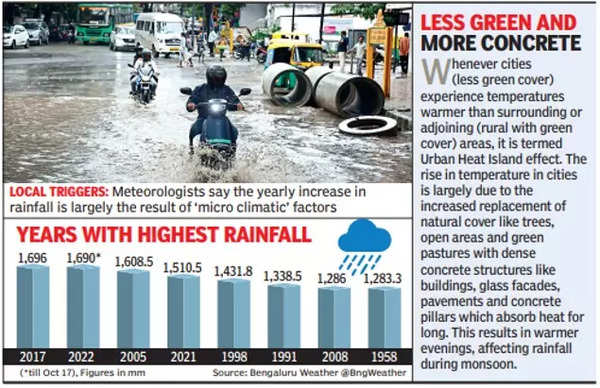The previous wettest year was 2017, when the city received 169.6 cm of rain, according to data from the India Meteorological Department (IMD).

Scientists from IMD Bengaluru told TOI that rainfall in the city is measured in three locations: Bengaluru City, HAL Airport and Kempegowda International Airport. “Bengaluru has recorded 169cm of rain so far (January 2022 to October 17, 2022). The city still needs 0.7cm to break the previous record for the wettest year set in 2017. But with two months and half remaining, 2022 will be the wettest year for Bengaluru since the start of climate data recording, “said Geeta Agnihotri, scientist and head of IMD Bengaluru. The department has data for Bengaluru rain since 1947.
In October alone, the city has so far received 22 cm of rain. “Typically, October marks the end of the southwest monsoon for Bengaluru, and the northeast monsoon usually arrives by October 15-20, resulting in rains in Kolar, Bengaluru Urban and Ballari. The onset of the retreating monsoon is expected in a few days, which will bring considerable rain to the city. If there is a depression on the Bay of Bengal, the city will receive more rain, “Agnihotri explained.
Debunking the idea that excess precipitation is due to climate change, meteorologists explain that global phenomena have nothing to do with the annual increase in precipitation since it is largely the result of “microclimatic” factors.
“It is mainly local factors ranging from landscape change to green area loss that are influencing the rainfall pattern in Bengaluru. Around the world, this has been the trend in several developed cities due to rampant change in the pattern of use of water. soil and the creation of heat islands, “Agnihotri clarified.
Scientists from the Indian Institute of Science (IISc) Divecha Center for Climate Change (DCCC) have indicated local factors for the phenomenon.
Leading DCCC scientist Professor J Srinivasan said annual rainfall in most of the tropics is increasing largely due to the increase in water vapor in the atmosphere triggered by the rise in global average temperature.
“In Bengaluru, for example, the rise in temperature is due to both global warming and the Urban Heat Island effect. Today, the urban regions of Bengaluru have many built-up areas that trap the heat of the sun and therefore the nights are. evenings are warmer in Bengaluru than in the surrounding areas, there is an increase in the upward movement of the air, which leads to cloud formation and increased rainfall in the evening or late in the evening, “explained Srinivasan.
He added that until the mid-20th century, rainfall in Bengaluru varied mainly due to changes in surface temperature in the tropical Pacific (El Nino or La Nina). “Changes in the Pacific Ocean alter the global circulation pattern, affecting rainfall around the world. This is called natural variability,” Srinivasan said.
